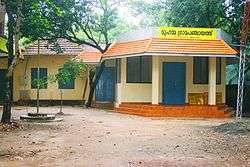Panchayati raj

The Panchayat raj is a South Asian political system found mainly in the nations of India, Pakistan, Bangladesh, Trinidad and Tobago, and Nepal. It is the oldest system of local government in the Indian subcontinent. The word raj means "rule" and panchayat means "assembly" (ayat) of five (panch). Traditionally panchayats consisted of wise and respected elders chosen and accepted by the local community. However, there were varying forms of such assemblies. Traditionally, these assemblies settled disputes between individuals and between villages.
The leader of the panchayat was often called the mukhiya or sarpanch, an elected or generally acknowledged position. The modern panchayati raj of India and its gram panchayats are not to be confused with either the traditional system nor with the extra-constitutional khap panchayats (or caste panchayats) found in northern India.[1]

Mahatma Gandhi advocated panchayat raj as the foundation of India's political system. It would have been a decentralised form of government where each village would be responsible for its own affairs.[2][3] The term for such a vision was Gram Swaraj ("village self-governance"). Instead India developed a highly centralised form of government.[4] However, this has been moderated by the decentralisation of several administrative functions to the local level, empowering elected gram panchayats.[5] There are significant differences between the traditional panchayati raj system, that envisioned by Gandhi, and the system formalised in India in 1992.[6]
See also
Notes and references
- ↑ Mullick, Rohit & Raaj, Neelam (9 September 2007). "Panchayats turn into kangaroo courts". The Times of India.
- ↑ Sisodia, R. S. (1971). "Gandhiji's Vision of Panchayati Raj". Panchayat Aur Insan. 3 (2): 9–10.
- ↑ Sharma, Manohar Lal (1987). Gandhi and Democratic Decentralization in India. New Delhi: Deep and Deep Publications. OCLC 17678104. Hathi Trust copy, search only
- ↑ Hardgrave, Robert L. & Kochanek, Stanley A. (2008). India: Government and Politics in a Developing Nation (seventh ed.). Boston, Massachusetts: Thomson/Wadsworth. p. 157. ISBN 978-0-495-00749-4.
- ↑ Pellissery, S. (2007). "Do Multi-level Governance Meet Local Aspirations?". Asia Pacific Journal of Public Administration. 28 (1): 28–40.
- ↑ Singh, Vijandra (2003). "Chapter 5: Panchayate Raj and Gandhi". Panchayati Raj and Village Development: Volume 3, Perspectives on Panchayati Raj Administration. Studies in public administration. New Delhi: Sarup & Sons. pp. 84–90. ISBN 978-81-7625-392-5.